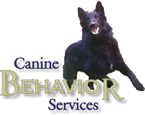 4 Tips for Teaching Your Dog More Reliable Stays 4 Tips for Teaching Your Dog More Reliable Stays
Training and behavior issues around here always seem to run in cycles. One week I may get more than my share of calls on dog-to-dog aggression. Another it may be fearful, traumatized dogs. Or people needing help bringing a previously outdoor dog into the home. Recently, it seems that I've been running into people with a more basic training issue - folks having questions and problems teaching "stay". In my experience, stay problems almost always come down to a few common training errors. I thought I'd start with some basic ones today, and move on to more advanced tips next week.
Know what you mean by "stay". Everybody knows what stays are - or do they? This may seem like a no-brainer, but surprisingly often, people have no clear-cut definition of stay. If we, as our dogs' trainers, don't know what stay means, how can we expect our dogs to know? Decide what stay will mean to you, and therefore, to your dog. To me, stay means that once the cue is given, the dog should 1) remain in the position (sit, down, stand, etc) she was in when she heard the stay cue, 2) remain in the spot I put her in (i.e. maintain the position, but also please do not skooch or creep or crawl across the room), 3) until I clearly instruct the dog that she is done with the stay. Your definition of stay does not need to match mine but, for your dog's sake, it should be black-and-white, with no grey, "soft" areas.
Convey quiet confidence in your attitude. Your body language will either help or hinder you in teaching stay to your dog. Stand with your body, including shoulders, upright and relaxed. Breathe normally, focusing your calm attention on your dog. Bowing, bobbing, and bending will make your dog think you are trying to play, and may entice your dog toward you. Conversely, standing stiff as a board may make your dog worried that something is wrong. ("Is she nervous about something? Should I be nervous? Maybe I shouldn't just sit here!"). The tone of your praise should be calm and sincere, not excited (you want the dog to stay in place, not leap up and play, after all), and not nervous or doubting (if you don't sound confident, how can your dog be?).
Time comes before distance. The first step of teaching your dog to stay is to teach the concept of staying for a period of time. This critical first step is, unfortunately, the one people often try to skip, in their rush to move away from their dog! Practice relatively short stays at first : five to fifteen seconds is is a perfectly good start. Slowly work up to longer stays as your dog gets the idea. Before even attempting to move away from your dog, you should have worked up to 1 to 3 minute long stays (I generally start with sit-stays) in several different places, all while remaining within 3-4 feet of your dog.
Reward staying, not getting up. All treats and targeted praise ("Good Sit! Good Stay!") should come during, not after, the stay exercise. Too often, owners repeat the command while the dog is staying, only praising the dog when she is done. This is a fundamental misunderstanding of how dogs learn. If you want your dog to keep staying, reinforce the stay itself, not its completion. Praising and treating when the stay is done teaches your dog that you are pleased when the stay is over - and results in shorter stays, rather than longer ones!
Play around with these this week, and see if you can improve those all-important stays! And until next week, Happy Training!
julie
Julie Cantrell BSc, CPDT-KA, CDBC
Canine Behavior Services
www.k9behaviorservices.com
|

